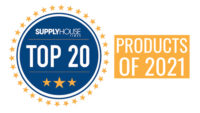Supply House Times Profile: Rick Wentzell
Bonomi Valves' Rick Wentzell celebrates 50 years in valve business, sharing perspective on current PVF landscape.

Rick Wentzell on October 1, 1971 and 50 years later in 2021 celebrating a long career in valve product design, sales and training.

Rick Wentzell on October 1, 1971 and 50 years later in 2021 celebrating a long career in valve product design, sales and training.


How many people reach a point to celebrate five complete decades working in the same industry? Better yet, who remembers the exact date they began their career? Bonomi Valves’ Rick Wentzell does. On Oct. 1, 1971, Wentzell began his career in the PVF industry and since that time has grown passionate about creating product, figuring out how best to sell it, and now, training the folks coming up.
Supply House Times Chief Editor Natalie Forster spoke with Wentzell to hear what a 50-year career in PVF means to him, how things have changed over the years and get his take on the current landscape.
SHT: Tell us about your background in the industry. How did you get started and what roles have you held?
RW: In 1969 I graduated from a school called St. Michael's college in Vermont and right after I graduated I received my draft notice and I was inducted into the US army. I was shipped out to Vietnam and served with the hundred first airborne division infantry in the Asia valley.
As many people know, coming home was a difficult time for many Vietnam veterans because of the anti-war; we were not welcomed home. I took the summer of 1971 off and by early fall I interviewed with a valve manufacturer — Watts Regulator in Lawrence, Massachusetts. On Oct. 1, 1971, I became a Boston area salesman for the company.
In 1974, I was transferred to Chicago to help start a new factory. Shortly after that, Watts Regulator decided they wanted to get into the ball valve business, which was a relatively new product at the time. So in 1976, I headed back to corporate to head up this new ball valve program; I was asked to come back and find out what we should make and how we should make it.
Through my time traveling the country expanding Watts Regulator’s ball valve market, I stumbled across the industrial ball valve sector. We were starting to make our own bronze balls, but now I found out that the real prize was if you could make carbon and stainless steel balls. After visiting the Gulf coast and petrochemical world, I found stainless and carbon ball valves to be the preferred product in the industrial market. So, we began to create our own versions of these, which I assisted in the design and debut to market of, and Watts Industrial Division was born in 1981.
In 1993, I took a job with Apollo Valves and by 1995, as imports were becoming more popular, I got approval to go look for an Italian ball valve. While there, I ran into Aldo Bonomi. He and I worked together to introduce Apollo’s first international commercial ball series, which was extremely successful. Long story short, Aldo had also wanted to start his own company and he asked if I would help him. So in 2003, I became General Manager of Bonomi USA. Since then, I’ve been helping Bonomi design new products, bring them to market and do product training.
SHT: What has been your favorite thing about your career in the valve industry?
RW: I’ve always really enjoyed bringing new things to market. Since the 1970s and 1980s, I’ve loved calling on customers and listening to what they want us to make, instead of just offering up product we do and don’t have. It’s always about solving an application problem for the customer when creating a new product.
Creating the strategy behind introducing new product has always been my passion and my strength. I like working with design engineers, participating in field testing and helping reevaluate the salesforce; teaching them how to sell specific products that are new to the market. I’m lucky enough that I get to still do these things today.
SHT: What are the greatest changes you’ve witnessed in the industry over the past 50 years?
RW: Well for starters, in the beginning of my career, I was making phone calls from phone booths along highways and in hotels. You had to wait in line — even in the rain or snow while trucks drive by splashing on you. Purchase orders were mailed through the post office and verbal POs were accepted.
Other than technology, one specific change I’ve seen is the focus on automation in the valve industry. In the seventies and eighties, PVF distributors generally wore a lot of hats and most of them did very well in automation. Many of the distributors had a specialist on staff that knew everything about automation and the accessories needed for these types of valves. From what I’ve seen, as many of these automation experts phased out of the industry, distributors have struggled to replace them. So many PVF distributors have gotten out of the automation business and stuck to pipes, valves and fittings.
SHT: What are the keys to success for a long career in the PVF industry? How should we be getting more young people in the business?
RW: It’s up to the company seeking to hire or hiring younger people to set the new hires up for a long-term career in the industry, vs. just hiring them to fill a slot. I see more generalists coming up as opposed to specialists. The younger folk out there may not have the training and skills to take on the PVF industry, but if they’re invested in and shown the path to success, they certainly can become skilled specialists.
We need to be loud about the goals of the company and the opportunities for growth throughout our industry. If younger people understand when they’re hired that there will be new positions opening up, new technologies to master, etc., we can spark more interest. In other words, get rid of the “slot” mentality and offer people a future, guiding them along the way.
SHT: As the industry navigates supply chain disruption — price increases, shipping delays, etc. – what should distributors and manufacturers be keeping an eye on? What advice do you have?
RW: I’ve seen this type of thing before. From 1973-1975 we experienced significant inflation and high oil prices which caused consistent monthly price increases for about a year. So all I can say is there isn’t anything we can do about it, so we must focus in riding it out. It’s very disruptive. You have to readjust your business, both on the manufacturer side and the distributor side. No manufacturer wants to raise their prices, and no one wants to be the first one to do it either.
My advice is to adjust your business practices in order to prepare as best you can and this will pass. When I say pass, I don’t mean prices coming all the way back down, I mean the landscape being calmer and more manageable. I’ve been through this before and in some ways, this is no different than what I’ve seen before; it’s just a different color. And the industry will get through it just like we have before.
SHT: How do you think the PVF sector is adapting to the digital changes it's facing?
RW: This is certainly still a people business, but not in the ways it used to be. Customer expectation and patterns are changing, even if you haven’t seen it directly yet. A lot of distributors are doing business on the internet, and if you’re not, you need to be. Consumers want specific product information readily available online. These products are sophisticated and detailed. Many customers now won’t call for more information if all you’re showing is a picture of a valve on your site — they’ll find another source that does give them the specifications and details they need.
It’s time consuming and difficult. I would advise distributors go to their vendors and say, “I need to set up my website with product information, can you help me?”
SHT: What trends do you expect to see emerge and grow over the next three to five years?
RW: The technology behind the valve automation process will continue to enhance and become more streamlined. Additionally, control valves and half-ball valve technology is catching on like wildfire, so I expect to see a lot of product changes in terms of valve design.
I also think the way we take new products to market will continue to change. Distributors are multi-faceted and busier now than ever before, so manufacturers and reps must come to the distributor with product knowledge that’s already been presented and accepted by the end-user. This takes the learning and training time off of the distributor, allowing them to run their business, sell and invest in product they know will sell.
Looking for a reprint of this article?
From high-res PDFs to custom plaques, order your copy today!





.jpg?height=200&t=1652414487&width=200)



